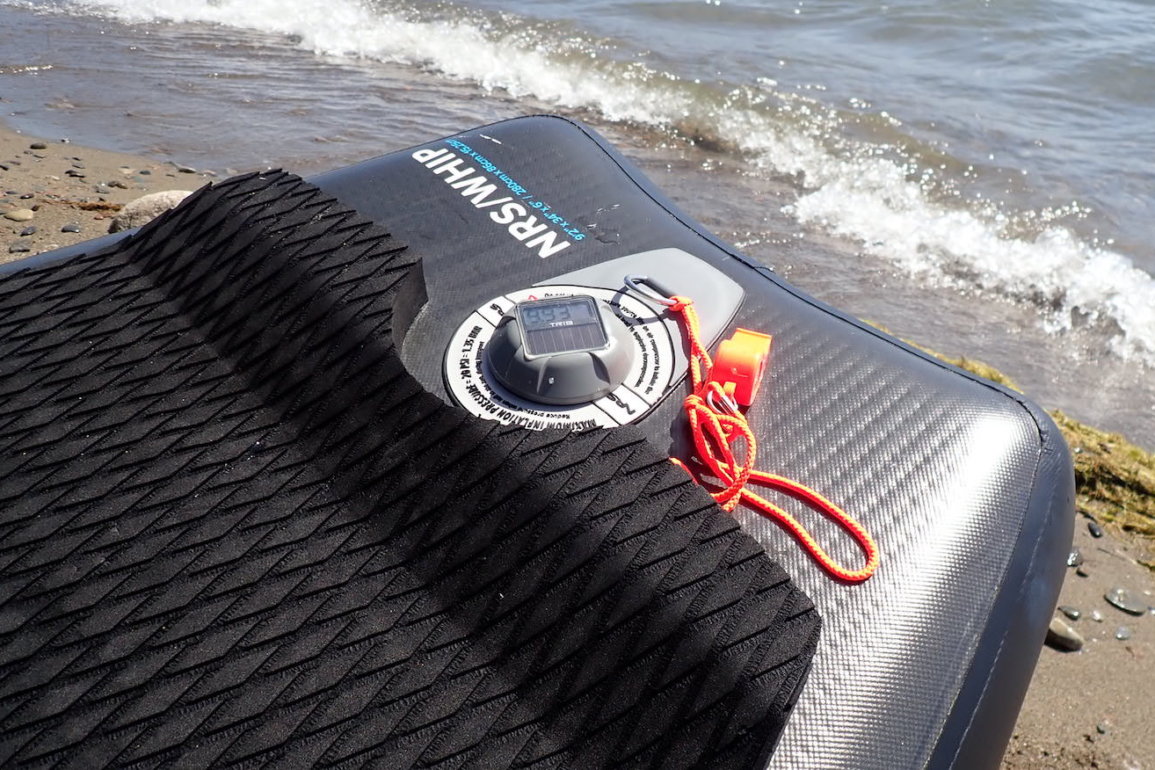The TRīB airCap Pressure Gauge is an innovative valve cap with a built-in, solar-powered display that shows air pressure in real time. It’s designed for rafts, standup paddle boards, and inflatable kayaks, all of which can experience big pressure changes throughout a day on the water.
The airCap is an invention from TRīB Outdoor Tech, a small Idaho company that launched after its founders experienced an inflatable kayak blowout on a remote float trip. In case you’re wondering, TRīB is pronounced with a long i, like “tribe.”
To get us a closer look, TRīB provided Man Makes Fire with two review units. This is what we learned:
TRīB airCap Pressure Gauge Review

The TRīB airCap is simply awesome. It’s easy to install. It works instantly, in real-time, and it even works in low light. Better yet, it teaches and warns you about air pressure fluctuations in your inflatable kayaks, rafts and SUPs.
There are two models, the airCap LF and the airCap HR.
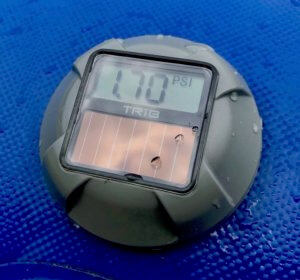
The airCap LF is for Leafield C7/D7 valves. The airCap HR is for Halkey-Roberts, Summit2 and most 1/4-turn valve styles. Many valves have markings like “C7” on them that tell you what they are, but if you’re not sure which kind of valve you have, check out the valve identification page at TRīB Outdoor.
The core functionality between the valves is essentially the same, but the HR version includes an over-pressure alarm that the user can turn on or off and set to any value between 0.5 and 20 psi.
Each airCap is shaped similar to the caps they replace, but they are approximately 1/4″ taller than standard caps. How long will the airCaps last? TRīB Outdoor expects frequently-used valves to last around 5 years but wouldn’t be surprised if recreational users get twice as many years (or more) out of their airCaps.
How Does the TRīB airCap Pressure Gauge Work?
A small but accurate air pressure gauge is fitted inside each cap and it runs immediately off of solar power. The airCap LF, which is what we tested, has a small rubber o-ring that creates an initial seal when you install it. You might be worried about losing air when you put the cap on . . . because when you put the cap on, you’ll be depressing the one-way valve. The initial rubber o-ring stops air loss. TRīB calls this a “make-before-break” double seal that prevents air from escaping during installation.
When fully seated, the primary rubber seal holds air just like standard caps.
The airCaps measure up to 20 psi. Many whitewater rafts and inflatable kayaks have a recommended air pressure of 2.5 psi. Many SUPs, on the other hand, are rated up to 20 psi. That’s a huge difference, and most recreational floaters have a hard time identifying proper pressure by feel alone.
Plus, as TRīB co-founder Erik Cegnar told us, “Most retail external pressure gauges are surprisingly inaccurate — and even if a rafter has one, they often don’t get them out and use them throughout the day.”
Building the pressure gauge into the cap itself makes it far more usable.
The Danger Is Real
If you’re reading this review, you probably want to know more about the pressure inside of your inflatables. You know that when the sun starts baking a raft, kayak or inflatable SUP, the pressure increases. In the morning, the air is colder and sunlight is weaker, so you add pressure to your inflatable. By midday, the sun and heat increases that pressure. To make it worse, many floaters and boaters get off the cool water and hit the beach for lunch, pulling their inflatable up on hot sand in the sun. Pressure rises.
How much? You don’t know. If you’re not paying attention, a seam could rupture, ruining your day. In fact, this happened on the Middle Fork of the Salmon River to the experienced paddlers who invented the TRīB airCap. But it could also happen when you hit a rock in a river, which is far worse than a blowout on a beach.
In addition, overinflation can stretch seams and prematurely weaken them without you noticing that anything is amiss . . . until a failure months or years later.
Just Let Some Air Out, Right?
If you’re paying attention as your inflatables get hot, you release some air. This is good, but what often happens is that you end up with an under-inflated craft, which doesn’t handle as well on the water.
The TRīB airCap lets you see the changes in pressure and make informed decisions in real time. That’s so awesome. Better yet, even if you’re the most experienced water expert in the world, you will likely take friends and family with you who aren’t as experienced. The very existence of a TRīB airCap on your inflatable makes it simple and fast to teach them about safe and optimal pressures. There’s no guesswork.
More importantly, with the TRīB airCap installed, you’re far more likely to run your raft, kayak and SUP at the appropriate air pressure, which will make it handle and perform better. Which means you will likely improve your skills faster and enjoy your time on the water even more.
Increase Your Performance
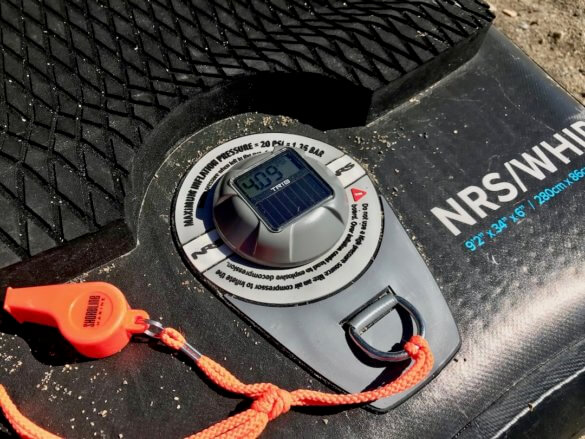
New inflatable stand up paddle boarders tend to under inflate their paddle boards. With kids and small adults, this isn’t such a big deal. For larger and heavy guys like me, an under-inflated paddle board is harder to use and harder to learn on. It flexes, making it less stable and less reactive.
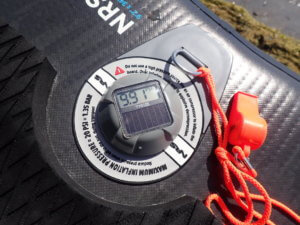
When I first tried the TRīB airCap on an NRS SUP, I found we were typically inflating the SUP to about 5 psi. That seemed pretty hard, but it would still flex more than I liked when I was paddling around in waves or choppy water. The NRS high-pressure pump that came with the NRS SUP was fairly accurate, but in my learning curve, I didn’t fully trust it because I had been around SUP users who avoided inflating their SUPs to higher pressures. In addition, after baking in the sun, we had no idea what the internal pressure was doing. The last thing I wanted was to ruin a day by busting a seam. So I would let air out when I didn’t really need to, which resulted in a softer experience on the water all over again.
After installing the TRīB airCap, I had far more confidence in ramping up the pressure. After getting over 10 psi, I noticed a remarkable difference in stability on the SUP — and it was easier for me to learn. I’m definitely still a novice, but even I could appreciate running the SUP at a higher pressure and knowing it was safe to do so. I can only imagine that this is even more important for SUPs that have lower pressure ratings of 10-to-15 psi . . . and certainly for any lower quality inflatable SUPs. Brand new NRS SUPs now come with 20 psi pressure release valves, but most SUPs do not.
If you’re not sure what pressure your inflatable should be running, check out TRīB’s recommended pressures page.
What About Rafts?
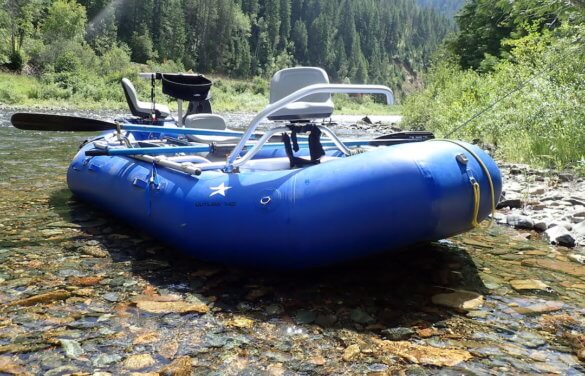
On one rafting trip, we started out in full sun with a raft sitting on the boat ramp, baking in the sun. Once we hit the cool river, though, cloud cover came in, the temp dropped, and we went through a series of runs in the shade. The raft felt sluggish to me, which I attributed to the extra people and weight compared to the day before. It wasn’t until we beached for lunch and I looked at the TRīB airCap that I realized I could safely benefit from more pressure.
One of TRīB’s core messages is simple: “Don’t guess. Know your craft.” The TRīB airCap will help you stay aware of your pressure at a glance, helping you get optimal performance out of your inflatables, reducing risk at the same time. Very highly recommended.

